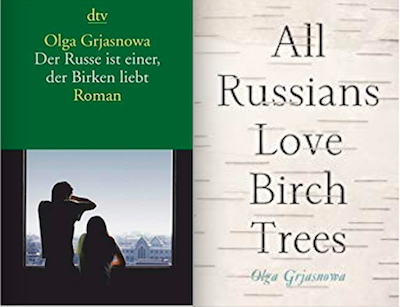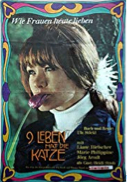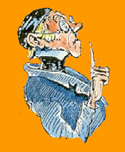Grammatical Gender
In English: Old English used to have grammatically gendered nouns, but during the Middle English period, roughly 1150 to 1500, this feature fell out of use. Grammatical gender exists now only in third-person singular pronouns: he (him/his), she (her/hers), and it (its). With a few quaint exceptions ("she" referring to a ship, for example), these pronouns are consistent with traditional concepts of biological gender.
Nowadays, however, those traditional concepts are being increasingly challenged, and language use reflects that. When people want to eliminate the gender distinctions that standard pronouns imply, they employ such alternatives as "he or she" or "s/he." "One" would seem to be another possible replacement, but it strikes listeners as overly stilted (in contrast to the pronoun "man" in German). The plural — and thus genderless — pronouns they, them, and their, on the other hand, are gaining acceptance as a substitute for he, she, etc.
Those seeking a more comprehensive reform that bypasses binary gender concepts altogether are proposing newly coined pronouns such as Zie, Sie, Ey, Ve, Tey, and E. These have yet to find wide-spread acceptance.
In German: grammatical gender exists for all nouns in the singular, but it and sex have little to do with one another.
The terms "masculine," "feminine," and "neuter" are conventions for grammarians, not biologists.
As Mark Twain, playing on the distiction, famously commented, "In German, a young lady has no sex, while a turnip has."
That being said, when modern Germans, in contrast to the Brothers Grimm, select a pronoun to refer to das Mädchen,
they normally use sie, not es.
When encountering a usual noun, however, learners of German soon discover that
common sense is rarely a good guide to figuring out whether it is der, die, or das.
Mostly, you just have to learn a noun's gender (and plural) along with the word itself.
There are, however, a few categories that might be of help:
Masculine:
- male humans and animals: der Mann [man], König [king], Vater [father], Löwe [lion], Bär [bear].
- days, months, seasons of the year, points of the compass: der Sonntag [Sunday], März [March], Herbst [autumn], Osten [East].
But: das Jahr [year], die Woche [week] (but: der Mittwoch [Wednesday]). - forms of precipitation, kinds of wind: der Regen [rain], Schnee [snow], Hagel [hail], Föhn [föhn], Monsun [monsoon], Orkan [hurricane].
- five words ending in -ee: der Kaffee [coffee], Klee [clover], Schnee [snow], Tee [tea], See [lake] (but note: die See [sea]).
- most nouns that are derived from (mostly) strong verbs but have no suffix: der Kauf [purchase], Wurf [throw], Sprung [jump], Riss [rip], Gang [gait]. Exception: das Schloss [lock; castle].
- most nouns ending in the
suffixes
-er, -el, -ling: der Lehrer [teacher], Wecker [alarm clock], Fremdling [stranger], Feigling [coward], Schlüssel [key].
But: die Trommel [drum], die Butter [butter], das Fenster [window], die Schwester [sister], die Mutter [mother], das Wetter [weather], das Zimmer [room]. - most nouns ending in -en: der Boden [floor; ground; soil], Regen [rain], Wagen [car; wagon].
- nouns with the suffixes -ant, -ar, -är, -ent, -eur, -ier, -ist, -or, -ismus: der Spekulant [speculator], Kommissar [commissar], Volontär [trainee], Friseur [barber], Student [student], Offizier [officer], Tourist [tourist], Lektor [(publisher's) editor; adjunct teacher], Kapitalismus [capitalism].
- brands of car: der Mercedes, Porsche, Ford.
Neuter:
- many offspring of humans and animals: das Kind [child], Kalb [calf], Küken [chick], Lamm [lamb].
- names of animals that include both male and female: das Pferd [horse], Schwein [pig], Schaf [sheep].
But: der Fisch [fish], der Hund [dog], die Maus [mouse], die Schlange [snake] - names of cities, continents, and most countries: das alte Berlin [old Berlin], Asien [Asia], Frankreich [France].
But: der Irak, der Iran, der Libanon; die Schweiz [Switzerland]; and countries ending in -ei: die Türkei [Turkey]. For more information on using articles with geographic locations, see http://faql.de/grammatik.html#geo. - metals und chemical elements: das Gold [gold], Silber [silver], Eisen [iron], Blei [lead], Chrom [chromium], Uran [uranium].
But: der Stahl [steel], der Schwefel [sulphur], die Bronze [bronze] - all words that are from other parts of speech that are used as nouns but do not signify people: das Essen [food; meal], Leben [life], Rauchen [smoking], das Ich [ego], das Schöne [Beauty; the Beautiful], das Wenn und Aber ["if, and, or but"], das Blaue [blue yonder], das A und das O [the alpha and omega].
- collective nouns: das Volk [folk], Gebirge [(group of) mountains], Besteck [cutlery], Geschirr [crockery, dishes].
But: der Gesang [song, singing]. - numbers when they indicate a set (of people, years, etc.): das Duo [duet], das Quintett [quintet], das Jahrzehnt [decade], das Dutzend [dozen], das Jahrhundert [century], das Jahrtausend [millenium].
- nouns with the suffixes -chen, -lein and -sel: das Mädchen [girl], Fräulein [Miss], Rätsel [puzzle], Mitbringsel [small present].
- nouns with the suffixes -ett, -ment and -um: das Ballett [ballet], Sonnett [sonett], Sakrament [sacrament], Parlament [parliament], Neutrum [neuter], Helium [helium].
Feminine:
- female humans and animals, often with -in: die Frau [woman], Tochter [daughter], Kuh [cow], Lehrerin [teacher], Ärztin [doctor], Wölfin [she-wolf].
- numbers and digits: die Eins [1], die Siebzehn [17], die Zweiundzwanzig [22].
But: see above concerning sets. - names of ships and airplanes: die Bismarck, die Europa, die Boeing.
- a great many words that end in -e: die Wanne [tub], Birne [pear], Tasse [cup], Zahnbürste [toothbrush], Wiese [meadow].
But: some are masculine: der Name [name], Junge [boy], Löwe [lion], Hase [rabbit, hare], Käse [cheese]. - all with the
suffixes
-ei, -heit, -keit, -schaft, -t, -ung: die Bäckerei [bakery], Krankheit [disease],
Freundlichkeit [friendliness], Gesellschaft [society; company], Fahrt [trip], Wohnung [apartment; abode].
But: der Sprung [jump (Here the "ung" is not a suffix; the noun comes from the verb "springen")]. - all with the suffixes -age, -enz, -esse, -euse, -ie, -ik, -ion, -itis, -tät, -ur: die Reportage [report], Lizenz [license], Delikatesse [delicacy], Friseuse [female barber], Melodie [melody], Politik [politics, policy], Nation [nation], Gastritis [gastritis], Universität [university], Natur [nature].
A number of homonyms are distinguished by their genders and often their plurals, e.g.:
- das Band (die Bänder) = tape, ribbon;
der Band (die Bände) = book volume; die Band (die Bands) = musical group.
der Erbe (die Erben) = heir; das Erbe (no plural) = inheritance.
der Flur (die Flure) = vestibule; die Flur (die Fluren) = pasture, field.
der Heide (die Heiden) = heathen; die Heide (die Heiden) = heath.
das Korn (die Körner) = grain, grain kernel; der Korn (die Korne/Korns) = grain whiskey.
das Schild (die Schilder) = sign, label; der Schild (die Schilde) = shield.
der See (die Seen) = lake; die See (die Seen) = sea.
das Teil (die Teile) = part, a component element; der Teil (die Teile) = share, portion.
der Wurm (die Würmer) = worm; das Wurm (die Würmer) = poor little thing, pitiable creature.
Controversies:
There are some nouns about whose genders even native speakers don't agree. Some differences are regional. In Austria and Upper Bavaria, for example, it is possible to say der Radio, rather than das. Sometimes the importation of a new word into the language creates uncertainty. For a discussion of some of these problems, see http://faql.de/genus.html
|
|
|
| The future is feminine, and so is the past! |
Germans, too, are attempting to overcome certain forms of gender distinction.
When a plurality of males and females is meant, the masculine designation no longer seems acceptable to cover both.
Thus, in addressing an audience, politicians will say, "Liebe Bürgerinnen und Bürger."
In writing, certain conventions work to group males and females together:
want ads, for example, are likely to say
something like "Sekretär/in gesucht" in order to invite applicants of either sex to apply.
Often an asterisk is employed to include both sexes: "Liebe Freund*innen und Kolleg*innen."
In contrast to English, however, there does not seem to be much effort on the
part of German-speakers to circumvent binary gender identity altogether.
Be reminded that we are not talking here about grammatical gender, but about nouns
that include biological gender in their meaning. As noted below, the plurals of German nouns have no
grammatical gender.
Most English plurals are formed simply by sticking an -s or, for purposes of pronunciation,
an -es onto the end of the singular:
cow → cows; kiss → kisses.
There are some exceptions: Separate from the question of how to form a plural is when to do so.
The choice is not always obvious. German plurals are even more complicated, being achievable in a variety of ways: by adding nothing at all or just an umlaut;
by tacking an -e or an -er on the end (with or without umlauting the stem); or by adding
-n; -en; -nen; -s; -es; or -se.
There are a number of further possibilities for words that are derived
from other languages. The good news is that these forms are not wholly arbitrary —
although the plural forms need to be learned along with the singular
and its gender, there are guidelines that furnish some predictability. A list of them, with examples, is appended below. A further piece of good news is that German plural nouns have no grammatical gender.
No matter what the gender was in the singular, the plural definite article in the
nominative case
is always die, the
accusative
is also die, the
dative
is den, and the
genitive
is der. With the exception of the dative den, the plural articles might possibly look like
those of the feminine singular, but the similarity
should be treated as a coincidence. Another aspect of the
dative plural
is that the noun itself adds an -n, unless the plural form already ends in -n
or -s:
![]()
Noun Plurals in English
But: belief → beliefs.
The same is true for loan words from other languages: biscotto → biscotti;
libretto → libretti; cherub → cherubim; goy → goyim;
chaise longue → chaises longues; raison d'être → raisons d'être.
The opposite phenomenon, the plurale tantum, has no singular form.
Among the many pluralia tantum in English are scissors, pants, police,
dregs, knickers, means, tropics, spectacles, pajamas, cattle,
riches, remains, tongs, throes, jitters, and manners.
Some plurale tantum designate geographical locations, often preceded by the article the:
The Andes, The Netherlands, The Seychelles, the boonies.

Noun Plurals in German
Die Männer fahren mit uns (The men are traveling with us).
Wir fahren mit den Männern (We're traveling with the men).
- Both languages, for example, share many examples of the singulare tantum when designating "uncountable masses":
die Butter (butter), die Milch (milk), der Rauch (smoke),
der Staub (dust), der Tau (dew).
Note, however, that while der Regen (rain) and der Schnee (snow) are singulare tantum, their English equivalents do have possible plurals: "The Rains of Castamere," "The Snows of Kilimanjaro." - Both languages also put certain abstractions only in the singular: die Armut (poverty), das Befinden (state of health; condition), die Gegenwart (presence; present time), die Hitze (heat), die Kälte (cold), die Ruhe (calm; rest; peace), der Überfluss (surplus), das Wissen (knowledge).
- The same is true of collective nouns (Sammelbezeichnungen) that have no plural: der Adel (aristocracy), der Hass (hatred), der Lärm (din; racket), das Laub (foliage), das Publikum (audience; public).
- das All, das Kosmos, and das Universum (all of which mean "universe" or "cosmos") are just three examples of words that, unlike their English equivalents, have no plural concept (See also "Abstract Nouns" below).
- Some collective nouns are singularia tantum in German, while their English equivalents are pluralia tantum: der Dank (thanks), das Gebäck (baked goods; pastries), die Moral (morals), das Vieh (cattle).
- In many cases, a plural version of a singulare tantum can be cobbled out of what is called a Sortenplural (or Artenplural), rendered in English as "kinds of ...": zwei Sorten Milch (two kinds of milk).
- When talking about a head of hair, English speakers use a collective noun: "She's letting her hair grow long."
The plural is reserved for individual hairs: "There are two hairs in my soup."
While Germans can also use the collective, especially when a coiffure is meant:
(Er trägt das Haar kurz [He wears his hair short]), they are even more likely to
employ the plural when speaking of countless hairs:
Meine Haare sind jetzt grau (My hair is now gray). Er hat sich die Haare schneiden lassen (He had his hair cut). - Note that das Obst (fruit [for eating]) has no plural, while die Frucht (fruit [in a botanical sense]) becomes die Früchte.
- In contrast, the English word "information" is always singular, while the German is usually plural: Informationen (pieces of information).
- The German word for pain (der Schmerz) appears mostly in the plural (die Schmerzen). The singular can be used for emotional or very general pain: Er empfand einen tiefen Schmerz über diesen Verlust (He felt a deep pain at this loss); Der Schmerz war furchtbar (The pain was terrible). Otherwise, the singular is reserved only for talking about a pain's characteristics or identifying its location. To ask the question, "Are you in pain?", one would use the plural: Haben Sie Schmerzen? Only the follow-up question might use the singular: Was für ein Schmerz ist das? (What kind of pain is it?). The answer could be something like ein stechender Schmerz (a stabbing pain) or ein Schmerz in der Schulter (a pain in my shoulder). When a pain is diagnosed or classed as belonging to a body part, it is plural — compare the English "-ache": Bauchschmerzen (bellyache), Kopfschmerzen (headache), Zahnschmerzen (toothache).
- Some German pluralia tantum (for which there is no singular): Daten (data [das Datum = "calendar date"]), Eingeweide (entrails), Einkünfte (income; revenue), Eltern (parents), Ferien (vacation; holidays), Kosten (cost; expenditure), Geschwister (siblings), Leute (people), Memoiren (memoir; memoirs), Pommes (French fries), Wirren (confusion; disturbances).
- Some homonyms are distinguished only in their plurals:
-
die Bank (bench) → die Bänke
die Bank (bank [financial institution]) → die Banken - das Wort (word [= a basic independent unit of vocabulary]) → die Wörter
das Wort (word [= part of a meaningful linguistic context]) → die Worte
Dieser Satz besteht aus sechs Wörtern (This sentence consists of six words). Seine inspirierenden Worte sind mir immer noch präsent. (His inspiring words are still with me). -
die Bank (bench) → die Bänke
- As pointed out above, British English considers some collective nouns to be plural, while American English treats them as singular: committee, family, team, government, audience, etc. German usage is similar to the American:
- As noted above, when expressing a measurement as an adjective, English often states the metric in the singular: a 15-foot ladder, etc. German does something similar when the metric is a masculine or neuter noun: zwei Glas Bier (two glasses of beer), drei Pfund Kartoffeln (three pounds of potatoes), zwei Stück Kuchen (two pieces of cake), zehn Sack Zement (ten sacks of cement), zwei Paar Schuhe (two pairs of shoes). The plurals of such metrics refer to the object itself:
- Currencies work much the same way: the unit of price is singular,
while the plural refers to actual coins:
Das Buch hat 20 Euro gekostet. (The book cost 20 euros). But: Ich hatte nur zwei Euros in der Tasche. (I only had 2 euros in my pocket). - If the measure is a feminine noun, however, the plural form is employed:
Like English, German also has singularia and pluralia tantum (nouns that have only singular or only plural forms), and they are usually used in similar ways.
| |
| (My family is very large). |
| Die jetzige Mannschaft ist ziemlich schlecht. |
| (The current team is pretty bad). |
| Der Kellner hat drei Gläser zerbrochen. |
| (The waiter broke three glasses). |
| Ich habe zwei Tassen Tee bestellt. |
| (I ordered two cups of tea). |
| Goethe soll täglich drei Flaschen Wein getrunken haben. |
| (Goethe supposedly drank three bottles of wine a day). |
- In making generalizations about national or ethnic groups, English-speakers usually use plural constructions ("Thais like spicy food"), while German-speakers often prefer the singular ("Der Thai isst gern scharf").
|
|
 |
| [How Olga Grjasnowa's German novel was translated] |
- In both English and German, the choice of whether to put a noun into the singular or plural is sometimes merely a stylistic one. It does not affect meaning, but it does correspond to patterns more likely to be adopted by native speakers. Consider the English assertion: "The children are picking their noses," which reflects the notion that more than one nose is involved. Germans, however, would be more inclined to treat the verbal complement as the primary framework: "Die Kinder bohren in der Nase." I.e., the fundamental predicate, "in der Nase bohren," takes precedence over the number of noses. Some other examples:
| Diese Leute sollten den Mund halten. |
| (These people ought to keep their mouths shut). |
| Etwas Schreckliches ist uns ins Auge gefallen. |
| (Something terrible met our eyes). |
| Er sieht wirklich krank aus. Wenn er über den Friedhof geht, binden sich die Würmer eine Serviette um den Hals. |
| (He really looks sick. When he walks through the cemetery, the worms tie napkins around their necks). |
- German and English treat abstract nouns somewhat differently.
In the singular, German attaches the definite article to certain
kinds of abstraction, while English does not: e.g.,
Die Liebe versagt nie (Love never fails).
Yet one can also say, Kinder brauchen Liebe (Children need love).
In other words, the German employs the article
when naming a unique abstract quality (die Liebe) and omits it when labeling
an individualized quality or entity whose form or quantity is of importance (Liebe).
Put another way, die Liebe refers to the absolute category of love, while Liebe
designates a specific kind of love.
The English structure does not mark this differentiation.
This same distinction shows up in plurals (or lack thereof). Note the difference between the German film title, "Das Leben der Anderen" and its English translation, "The Lives of Others." In the German title, das Leben, the "others" all participate in a general category of "life." In the English title, they live individual lives, a concept that is more complicated to express in German. There is, to be sure, a plural form of das Leben: die Leben. But the plural individualizes the concept, by implication contrasting it with the general category: Samuel Koch's autobiography and Georg Maas's film, both entitled "Zwei Leben," as well as Ula Stöckl's film, "9 Leben hat die Katze", use the plural to stress the discontinuities within what English would feel comfortable calling the protagonists' "lives".



These differing plural concepts lead to some interesting contrasts between the two languages. For example, Peter Tse, a brain scientist, encountered difficulties translating a particular idea into German: "The split-brain patient has two consciousnesses, each of which has multiple futures open to it." The problem is that both das Bewusstsein ("consciousness") and die Zukunft ("future") are singularia tantum. In contrast to English, German gives neither concept an acceptable plural, reflecting how differently the two languages conceive of the continuity of the self. Recourse to a Sortenplural (e.g., zwei Sorten von Bewusstsein ["two kinds of consciousness"] or mehrfache Arten von Zukunft ["multiple kinds of future"]) creates a very different meaning.

- die Blume (flower) → die Blumen; die Frage (question) → die Fragen; die Stunde (hour) → die Stunden; die Tasse (cup) → die Tassen; die Feder (feather) → die Federn; die Schwester (sister) → die Schwestern; die Schachtel (box) → die Schachteln.
- die Bäckerei (bakery) → die Bäckereien; die Krankheit (illness, disease) → die Krankheiten; die Nationalität (nationality) → die Nationalitäten; die Universität (university) → die Universitäten; die Eitelkeit (vanity) → die Eitelkeiten; die Gesellschaft (society, company) → die Gesellschaften; die Mischung (mixture) → die Mischungen.
- das Bett (bed) → die Betten; die Fabrik (factory) → die Fabriken; die Frau (woman) → die Frauen; das Verb (verb) → die Verben.
- A majority of neuter nouns form their plural with an -e: das Pferd (horse) → die Pferde; das Dokument (document) → die Dokumente; das Gespräch (conversation) → die Gespräche; das Schaf (sheep) → die Schafe; das Schwein (pig) → die Schweine.
- Almost 90% of masculine nouns add an -e and, usually, an umlaut: der Arzt (physician) → die Ärzte; der Fluss (river) → die Flüsse; der Fuß (foot) → die Füße; der Koch (cook) → die Köche; der Kuss (kiss) → die Küsse; der Stuhl (chair) → die Stühle; der Traum (dream) → die Träume; der Wunsch (wish) → die Wünsche.
- While most of the nouns in this category take an umlaut, some do not. Of course, only the vowels a, o, and u are at all eligible for an umlaut. Within diphthongs or digraphs (au, ai, ei, eu, ie), only au can be umlauted, becoming äu.
- Some examples: der Griff (grip, handle) → die Griffe, and der Schrei (scream, shout) → die Schreie.
- But there are also some masculine nouns that take an -e in the plural without umlauting the a, o, or u that they contain: der Hund (dog) → die Hunde; der Monat (month) → die Monate; der Tag (day) → die Tage.
- Approximately 25% of feminine nouns have the plural form -e with an umlaut: die Gans (goose) → die Gänse; die Macht (power) → die Mächte; die Maus (mouse) → die Mäuse.
- Neuter: das Bad (bath) → die Bäder;
das Bild (picture) → die Bilder;
das Blatt (leaf) → die Blätter;
das Buch (picture) → die Bücher;
das Dorf (village) → die Dörfer; das Ei (egg) → die Eier;
das Gesicht (face) → die Gesichter; das Haus (house) → die Häuser;
das Kind (child) → die Kinder;
das Königtum (kingdom) → die Königtümer; das Volk (people) → die Völker.
Some masculine examples: der Mann (man) → die Männer; der Mund (mouth) → die Münder; der Wald (forest) → die Wälder. - Some nouns that belong to this "weak" category must be learned individually, such as:
der Mensch (human being) → die Menschen; der Nachbar (neighbor) → die Nachbarn;
der Fotograf (photographer) → die Fotografen.
(Der Herr is the exception: its accusative singular form is den Herrn, but its plural is die Herren). - All masculine nouns that end in -e (with the exception of der Käse [cheese], which is not a weak noun): der Name (name) → die Namen; der Kunde (customer) → die Kunden; der Junge (boy) → die Jungen; der Riese (giant) → die Riesen; der Glaube (belief) → die Glauben; der Gedanke (thought) → die Gedanken; der Experte (expert) → die Experten; der Kollege (colleague) → die Kollegen.
- All nouns ending in the suffixes -ant, -arch, -ent, -ist, -oge, -om, -oph, and -ot: der Komödiant (comedian) → die Komödianten; der Patriarch (patriarch) → die Patriarchen; der Student (student) → die Studenten; der Tourist (tourist) → die Touristen; der Anthropologe (anthropologist) → die Anthropologen; der Astronom (astronomer) → die Astronomen; der Philosoph (philosopher) → die Philosophen; der Pilot (pilot) → die Piloten.
- National designations of males that are created with -e, such as: der Franzose (Frenchman) → die Franzosen; der Russe (Russian) → die Russen; der Schwede (Swede) → die Schweden; der Türke (Turk) → die Türken.
- If that person is a male, -er is added to the verb stem, and the plural is identical with the singular: der Arbeiter (worker) → die Arbeiter; der Fahrer (driver) → die Fahrer; der Maler (painter) → die Maler; der Nichtstuer (do-nothing) → die Nichtstuer; der Spieler (player) → die Spieler; der Trainer (coach) → die Trainer.
- If the person is female, the suffix is -erin, and the plural is formed with -nen (The doubling of the -n keeps the preceding vowel [-i-] short [much as with the -se plural described below]): die Arbeiterin → die Arbeiterinnen; die Fahrerin → die Fahrerinnen; die Malerin → die Malerinnen; die Nichtstuerin→ die Nichtstuerinnen; die Spielerin → die Spielerinnen; die Trainerin → die Trainerinnen; die Botschafterin → die Botschafterinnen; die Eisenbahnerin → die Eisenbahnerinnen; die Schülerin → die Schülerinnen.
- The males: der Berliner → die Berliner; der New Yorker → die New Yorker; der Kanadier → die Kanadier; der Engländer → die Engländer; der Norweger → die Norweger; der Schweizer → die Schweizer.
- The females: die Berlinerin → die Berlinerinnen; die New Yorkerin → die New Yorkerinnen; die Kanadierin → die Kanadierinnen; der Engländerin → die Engländerinnen; die Norwegerin → die Norwegerinnen; die Schweizerin → die Schweizerinnen.
- die Ärztin (physician) → die Ärztinnen; die Chirurgin (surgeon) → die Chirurginnen; die Französin (Frenchwoman) → die Französinnen; die Professorin (professor) → die Professorinnen; die Touristin (tourist) → die Touristinnen.
- der Bagger (power shovel)→ die Bagger; der Fernseher (television set) → die Fernseher; der Kopierer (copier)→ die Kopierer; der Kugelschreiber (ballpoint pen) → die Kugelschreiber; der Lichtschalter (light switch) → Lichtschalter; der Rasenmäher (lawn-mower) → die Rasenmäher; der Scheibenwischer (windshield-wiper) → die Scheibenwischer; der Schläger (racquet, bat, club) → die Schläger; der Schraubenzieher (screwdriver) → die Schraubenzieher; der Staubsauger (vacuum-cleaner) → die Staubsauger; der Wecker (alarm-clock) → die Wecker; der Zahnstocher (toothpick) → die Zahnstocher.
- die Schachtel (box) → die Schachteln; die Schwester (sister) → die Schwestern; die Feder (feather; quill pen) → die Federn. Two exceptions: die Tochter (daughter) → die Töchter; die Mutter (mother) → die Mütter.
- das Gemälde (painting) → die Gemälde; das Gebäude (building) → die Gebäude; das Gebirge (mountain range) → die Gebirge; das Gerippe (skeleton) → die Gerippe; das Gewitter (thunderstorm) → die Gewitter.
- das Gebüsch (shrubbery, copse) → die Gebüsche; das Geräusch (noise, sound) → die Geräusche; das Geschenk (gift) → die Geschenke; das Gespräch (conversation) → die Gespräche; das Getränk (beverage) → die Getränke.
- der Geruch (smell) → die Gerüche; der Gesang (song, singing) → die Gesänge.
- das Brötchen (bread roll) → die Brötchen; das Frühchen (premature baby) → die Frühchen; das Grübchen (dimple) → die Grübchen; das Mädchen (girl) → die Mädchen; das Märchen (fairy tale) → die Märchen; das Schläfchen (nap) → die Schläfchen; das Schnäppchen (a bargain) → die Schnäppchen; das Fräulein (Miss; young unmarried woman) → die Fräulein (although die Fräuleins can be used colloquially).
- das Essen (food, meal) → die Essen; das Treffen (meeting, gathering) → die Treffen.
Note, however, that most such nouns are singularia tantum: das Wissen (knowledge); das Denken (thinking). - Those without added umlaut: der Abstecher (side-trip) → die Abstecher; der Deckel (lid) → die Deckel; der Fehler (error) → die Fehler; der Garten (garden) → die Gärten; der Gürtel (belt) → die Gürtel; der Hebel (lever, crank) → die Hebel; das Kabel (cable, cord) → die Kabel; das Mittel (means, measure) → die Mittel; der Onkel (uncle) → die Onkel; der Schnitzer (blunder, howler) → die Schnitzer; der Seufzer (sigh) → die Seufzer; der Treffer (strike, hit, success [something that hits the mark]) → die Treffer; der Wagen (car) → die Wagen.
- Those adding an umlaut: der Apfel (apple) → die Äpfel; der Boden (floor, soil) → die Böden; der Mantel (coat) → die Mäntel; der Vater (father) → die Väter.
- Two feminine nouns add the umlaut: die Mutter (mother) → die Mütter; die Tochter (daughter) → die Töchter.
- Two masculine nouns ending in -el and -er that take an -n: der Bauer (farmer, peasant) → die Bauern; der Muskel (muscle) → die Muskeln.
- das Ärgernis (annoyance; offense) → die Ärgernisse; das Bedürfnis (need) → die Bedürfnisse; das Begräbnis (burial) → die Begräbnisse; die Besorgnis (anxiety; apprehension) → die Besorgnisse; das Ereignis (event; occurrence) → die Ereignisse; die Erkenntnis (knowledge, cognition, perception) → die Erkenntnisse; das Erzeugnis (product) → die Erzeugnisse; die Finsternis (darkness; gloom) → die Finsternisse; das Gedächtnis (memory) → die Gedächtnisse; das Gefängnis (prison) → die Gefängnisse; das Geheimnis (secret) → die Geheimnisse; das Geständnis (confession) → die Geständnisse; das Hindernis (barrier; hindrance) → die Hindernisse; das Verhängnis (fate; doom) → die Verhängnisse; das Verständnis (understanding; comprehension) → die Verständnisse; das Verzeichnis (catalogue; list) → die Verzeichnisse; die Wildnis (wilderness) → die Wildnisse. This doubled consonant can also be used to preserve the short vowel in the noun stem itself: der Bus (bus) → die Busse; der Zirkus (circus) → die Zirkusse.
- der Käse (cheese) → die Käse — a masculine noun that ends in -e but does not have an -n plural.
- das Konto ([bank] account) → die Konten.
- das Knie (knee) → die Knie — but pronounced as if an -e (-ə [= schwa]) had been added as an extra syllable ("Knie-e").
- A similar additional syllable shows up with der See (lake) and die See (sea). They both have the plural die Seen, pronounced ("See-en").
- Nouns ending in -erie also take an -n in the plural, with the result pronounced with an extra syllable: die Confiserie (cake shop) → die Confiserien (pronounced "Confiserie-en"); die Drogerie (drugstore) → die Drogerien ("Drogerie-en"); die Fantasie (fantasy, imagination) → die Fantasien ("Fantasie-en"); die Patisserie (cake shop) → die Patisserien ("Patisserie-en").
- That contrasts with nouns ending in -ei, which take an -en plural that is both written and pronounced: die Bäckerei (bakery) → die Bäckereien; die Metzgerei (butcher shop) → die Metzgereien).
- A few words have an -ien ending: das Adverb (adverb) → die Adverbien; das Prinzip (principle) → die Prinzipien.
- das Antibiotikum (antibiotic) → die Antibiotika; das Tempus (tense) → die Tempora; das Lexikon (dictionary, encyclopedia) → die Lexika; die Nova (nova) → die Novae.
- das Aquarium (aquarium) → die Aquarien; das Datum (date, datum) → die Daten; das Ministerium (governmental department) → die Ministerien; das Museum (museum) → die Museen; das Studium (studies, course of study) → die Studien; das Epos (epic) → die Epen; die Praxis (practice [of law or medicine]) → die Praxen; die Firma (firm, company) → die Firmen; die Villa (villa) → die Villen; der Rhythmus (rhythm) → die Rhythmen. For a more complete listing, see http://faql.de/numerus.html
- Members of a family group (The English equivalent is always preceded by "the," but in German the "die" is optional):
- Abbreviations (including terms of endearment) used as nouns: der Ami (Amerikaner) → die Amis; die DVD (Digital Video Disk) → die DVDs; die GmbH (Gesellschaft mit beschränkter Haftung [= limited liability company]) → die GmbHs; der Juso (Jungsozialist [= member of the youth organization of the SPD]) → die Jusos; der LKW (Lastkraftwagen [truck, lorry] → die LKWs; der Trabi (Trabant [kind of auto manufactured in the German Democratic Republic]) → die Trabis; die Mutti (Mommy) → die Muttis; der Opa (Grandpa) → die Opas.
- Certain imported nouns, primarily those that have been derived from English, French, and Italian.
These plural nouns do not add an -n in the dative case:
Wir haben zweimal in Hotels übernachtet (We twice stayed in hotels).
A few other examples:
das Auto → die Autos;
die Kamera → die Kameras;
der Park → die Parks;
das Menü → die Menüs;
das Video → die Videos.
In some cases, the speaker has a choice between the -s and the original language's plural: das Cello → die Cellos or die Celli; das Libretto → die Librettos or die Libretti. Although this -s plural can reflect a word's English origin, it does not always adhere to the whole form, as when the final -y is retained, rather than changed to -ie: die Hobbys, die Partys. This is also true of the bogus anglicism, das Handy (pronounced "Händy" in an attempt to mimic the "a" [æ] of its fictional American origin). Its plural is thus Handys. Some loan nouns, especially those derived from verbs and ending in -er, have adapted themselves to the German process of creating plurals, eschewing the -s. Der Computer → die Computer, and it receives the dative -n in the plural: Wir arbeiten mit mehreren Computern (We work with several computers). Another example:

Better protection of whistlerblowers
Feminine nouns that end in -e form their plural with -n, as do most ending in -el or -er. These never add an umlaut.
All nouns ending in the suffixes -ei, -heit, -ität, -keit, -schaft, -ung are feminine and have the plural -en:
Some other nouns with the plural -en:
Plurals that are achieved with -e:
Plurals with an added -er: About a fifth of all neuter nouns and a few masculine ones form their plural with -er and, when possible, an umlaut:
The plurals of nouns that have been derived from adjectives (adjectival nouns) are formed by adding either -e or -en, consistent with their grammatical context:
| Die Besten sind schon verheiratet. |
| (The best ones are already married). |
| Rechtsradikale sind hier unerwünscht. |
| (Right-wing radicals aren't welcome here). |
The endings -n or -en also form the plural with the class of so-called weak masculine nouns, which in the singular take an -n or -en in the accusative, dative, and genitive cases — although sometimes -s or -ns in the genitive). Their plural form is the same as that of the accusative singular (-n or -en).
Other "weak nouns" are predictable:
-er / -erin: A great many nouns are derived from verbs and indicate a person who performs the action that the verb describes. The same pattern can apply to certain categories not defined by a verbal action. Note again that in the plural, the only gender distinction is in the meaning, not in the grammatical form.
Some other categories of persons are based not on a verb, but rather on where the category is found: der Botschafter (ambassador) → die Botschafter; der Eisenbahner (railwayman) → die Eisenbahner; der Schüler (school pupil) → die Schüler.
The same patterns apply to people from a particular city or country.
In fact, anytime that the suffix -in (sometimes with an umlaut) is used to designate a female, the plural is -nen. Again: the doubling of the consonant -n keeps the preceding vowel [-i-] short:
This type of -er suffix is not confined to people, but can also indicate an inanimate instrument. Here, too, it is masculine and the singular and plural forms are identical:
Most feminine nouns ending with the suffixes -el or -er have the plural -n. These never add an umlaut.
Collective neuter nouns beginning with Ge- have plurals that are identical to their singular forms or add an -e:
Collective masculine nouns can add an umlaut in addition to the -e:
All nouns ending with the suffixes -chen or -lein have plurals that are identical to their singular forms:
Neuter nouns derived from verb infinitives also have plurals that are identical to their singular forms:
|
|
|
| We welcome all nationalities here, since we are all sometimes foreigners |
Nearly all masculine and neuter nouns that end in -er, -en, or -el also have plurals that are identical to their singular forms or else just add an umlaut.
Nouns ending in the suffix -nis add another -s- before the plural suffix -e. The doubling of the -s keeps the preceding vowel (-i-) short (The same principle applies to the the adding of -nen to pluralize the feminine suffix -in [see above]):
Some unusual plurals:
Nouns that are derived from (or perceived to be derived from) Latin and Ancient Greek sometimes bring along their original plural forms. This is particularly true of words from specialized fields:
More commonly, nouns that originate in Latin or Greek and end in -um, -os, -is, -a, or -us usually take the plural ending -en:
Plurals formed by adding an <-s> are found in several categories:
| Siemethofers haben sich eine Waschmaschine angeschafft. |
| (The Siemethofers have bought themselves a washing machine). |
| Die Manns haben ein modernes Haus in Pacific Palisades gebaut. |
| (The Manns built a modern house in Pacific Palisades). |
